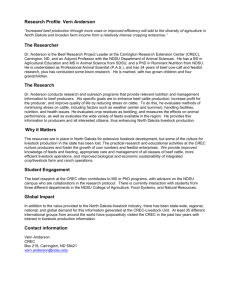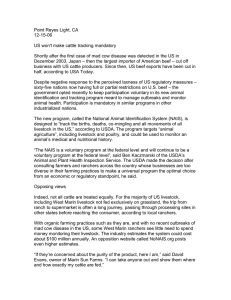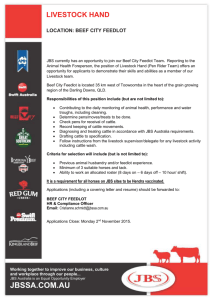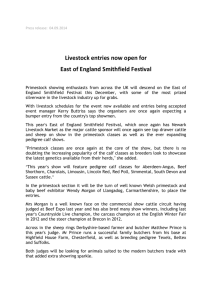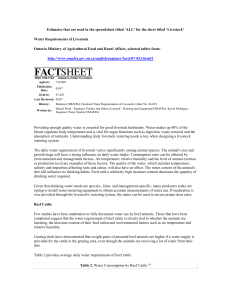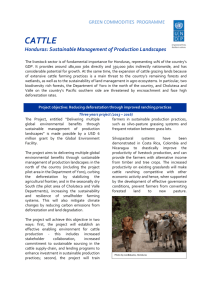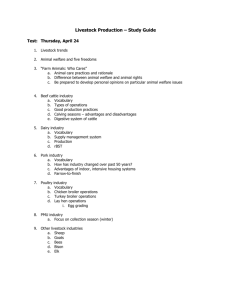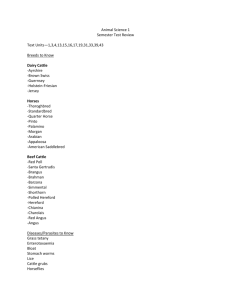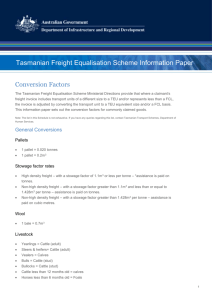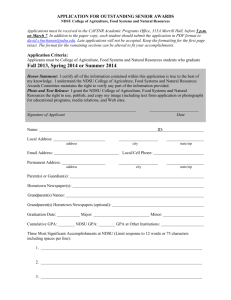KimVannahmeFINAL22
advertisement
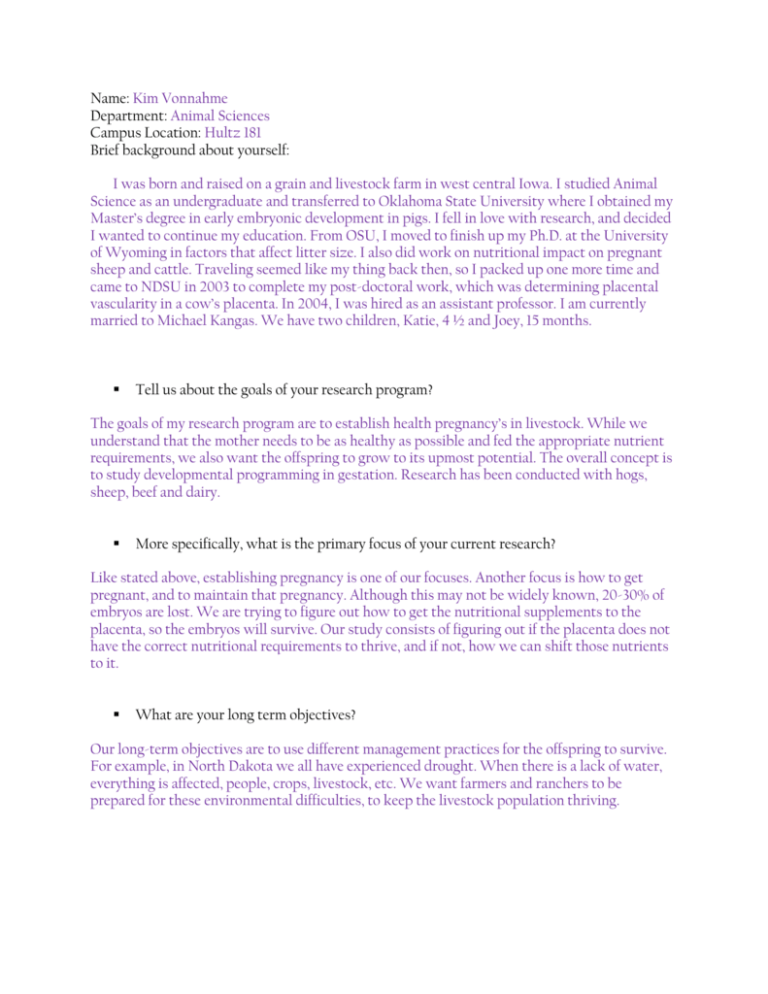
Name: Kim Vonnahme Department: Animal Sciences Campus Location: Hultz 181 Brief background about yourself: I was born and raised on a grain and livestock farm in west central Iowa. I studied Animal Science as an undergraduate and transferred to Oklahoma State University where I obtained my Master’s degree in early embryonic development in pigs. I fell in love with research, and decided I wanted to continue my education. From OSU, I moved to finish up my Ph.D. at the University of Wyoming in factors that affect litter size. I also did work on nutritional impact on pregnant sheep and cattle. Traveling seemed like my thing back then, so I packed up one more time and came to NDSU in 2003 to complete my post-doctoral work, which was determining placental vascularity in a cow’s placenta. In 2004, I was hired as an assistant professor. I am currently married to Michael Kangas. We have two children, Katie, 4 ½ and Joey, 15 months. Tell us about the goals of your research program? The goals of my research program are to establish health pregnancy’s in livestock. While we understand that the mother needs to be as healthy as possible and fed the appropriate nutrient requirements, we also want the offspring to grow to its upmost potential. The overall concept is to study developmental programming in gestation. Research has been conducted with hogs, sheep, beef and dairy. More specifically, what is the primary focus of your current research? Like stated above, establishing pregnancy is one of our focuses. Another focus is how to get pregnant, and to maintain that pregnancy. Although this may not be widely known, 20-30% of embryos are lost. We are trying to figure out how to get the nutritional supplements to the placenta, so the embryos will survive. Our study consists of figuring out if the placenta does not have the correct nutritional requirements to thrive, and if not, how we can shift those nutrients to it. What are your long term objectives? Our long-term objectives are to use different management practices for the offspring to survive. For example, in North Dakota we all have experienced drought. When there is a lack of water, everything is affected, people, crops, livestock, etc. We want farmers and ranchers to be prepared for these environmental difficulties, to keep the livestock population thriving. How do you feel it will impact the region, nationally, globally? In conjunction with the questions above, during a time of drought, forage quality will not be as good, therefore the pregnant dams will need to be supplemented. We want the farmers and ranchers to be aware that when the environment does not cooperate, it not only affects the living animal, but it also affects the offspring that is trying to grow. Essentially, we want to be good stewards of agriculture. We want to create healthier livestock and reproductive performance in the uterus, to generate a better life. When finished, what will your work mean? What will it mean to the state of ND? This is currently a worldwide project that is being studied and researched all across the nation. While a good majority is focused on the biomedical side, I am concerned with the Ag purpose of the project and the ability to give recommendations to ranchers on when and what to feed their animals. I want to figure out the factors that will help the placenta flourish. Perhaps that being feeding more nutrients over a short period of time when we know there is going to be outside factors affecting the growth. With this research helping the ranchers of ND, there is also a side of this research that would help the farmers. There are many different kinds of crops grown in North Dakota, and if we can find the appropriate crops that would maximize the placental growth during gestation, farmers would not have to worry about marketing their grain elsewhere. What excites you the most about your project? What excites me the most is the time of supplementation, and how it affects the blood flow in beef cattle. We have realized that ewes and beef cattle respond to stressors quite differently. When we first began this project, we assumed they would have quite similar reactions, but we soon realized they need different nutrient requirements, and that has brought in many new questions. I like the idea of circulating new questions. It keeps the wheels in your brain turning, and you are constantly learning. Do you have any graduate/undergraduates helping with this project? My graduate students are Leticia Camacho, Arshi Reyaz, Bethany Mordhorst, Leslie Lekatz, Craig Zimprich, and Samantha Kaminski. My undergraduate students are Ellen Nere and Paige Laufer. Arshi did the vascular function work and Leticia did the whole animal work- uterine blood flow for this particular project. Beth and Craig have also done beef cattle ultrasound work and Leslie’s research has focused on maternal nutrition in sheep. Ellen and Paige helped with many different aspects of the project; feeding cows, helping with dissection, working with cattle, etc. This helps them develop new questions, which leads into new experiments. For me, it seems like a project is really never over. Even after a projected is ‘completed’ there are always questions that stem from it, that keep us searching for more questions. What is the greatest reward after the completion of a project? One of the greatest rewards is getting other students excited about future research projects. I like having the students take responsibility, and make it into their own project. This helps them develop new questions, which leads into new experiments. For me, it seems like a project is really never over. Even after a projected is ‘completed’ there is always questions that stem from it, that keep us searching for more questions. Do you teach any undergraduate or graduate level classes? I teach AnSci 463 and Independent Study course Research and Reproduction. What is your advice for students who want to go into your field of study? An upper hand they already have is attending NDSU as an undergraduate. NDSU is unique in that it lets undergraduates help in the lab and work on research projects. There are a lot of teachers who are researchers, so the odds are you can contribute to research by just asking. This allows you to gain knowledge and experience in the field of research, and helps you decide future plans. Other advice I always tell students is that science is living. It is always changing and new knowledge can always be acquired. What are some of your hobbies/activities you like to do when you are not spending time on your research project? When I am not working on my research project or in the office, I really enjoying spending time with my children. Please provide us with your contact information: Kimberly A Vonnahme Email kim.vonnahme@ndsu.edu Phone (701) 231-5883 Department AES Animal Science Title Associate Prof Office Hultz 181 Group faculty
